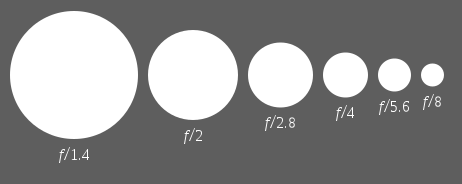The Exposure Trinity
A good way to retain stuff you learn is to write it down...
The Exposure Trinity
There are 3 major components which directly affect a photographs exposure:
1. Aperture opening - How big the aperture is
2. Shutter speed - How long light is allowed to hit the sensor
3. ISO - sensor sensitivy
The Aperture is a hole through which light passes. How big this hole is set affects how much light flows. The size of the hole is usually indicated in f-stops (f/1.8, f/8....). This is a ratio of the lens focal length to the aperture diameter. A full f-stop, refers to a 1.414 * f-number, this has a corresponding 2x change in light intensity. For example f/1.4 is a full stop away from f/2, allows 2x light compared to f/2. The image below illustrates different f-stops and the corresponding hole size.
 (image source: http://upload.wikimedia.org/wikipedia/commons/thumb/8/87/Aperture_diagram.svg/462px-Aperture_diagram.svg.png)
(image source: http://upload.wikimedia.org/wikipedia/commons/thumb/8/87/Aperture_diagram.svg/462px-Aperture_diagram.svg.png)In relation to how big the aperture opening is, is how long light flows through this hole. This is what is more commonly called as shutter speed. So, to get the same amount of light, you can have several aperture-shutter speed pairings. A good analogy would be a faucet: You can open the faucet to allow just a trickle of water to flow for lets say 20 sec. The water you accumulated in that time could also be achieved with the faucet fully open for maybve 1/250sec.
The third component to "The Trinity", although less frequently adjusted, is ISO (or ASA). This is an indicator or how sensitive the sensor is to light. The lower the ISO, the less the sensitivity to light. Be aware though, that as light sensitiviy is increased, so does noise.
A question I got from a friend a while back was: "If different aperture and shutter speed settings give me the same exposure, why don't I just set it to one and use that everytime?"....
